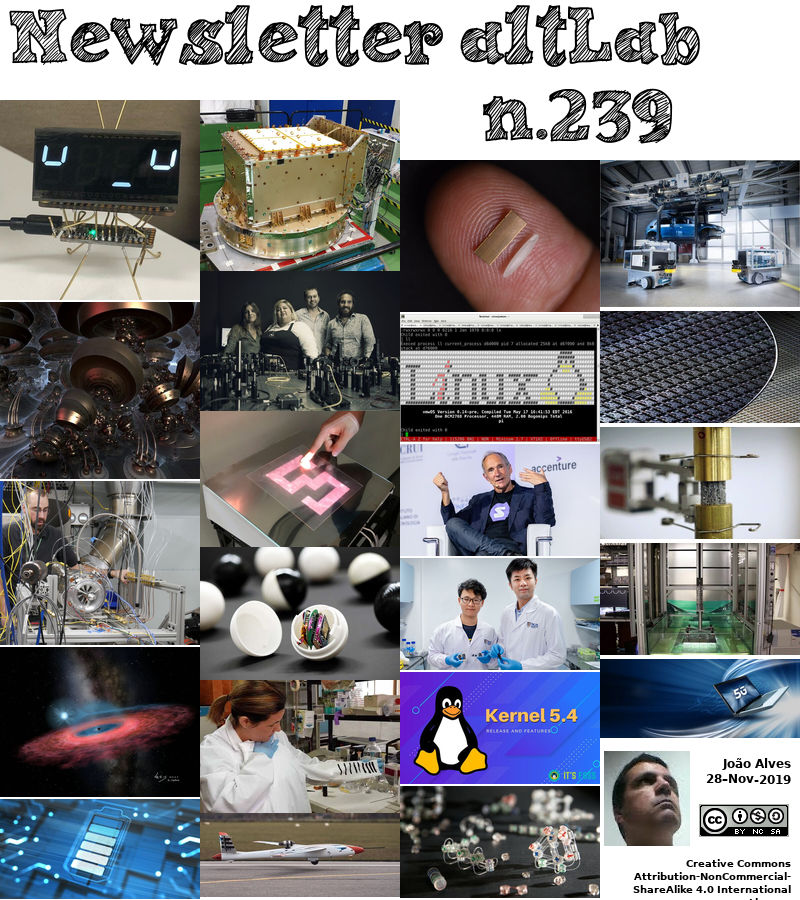2019-11-28 - Nº 239
Editorial
Esta é a Newsletter Nº 239 que se apresenta com o mesmo formato que as anteriores. Se gostar da Newsletter partilhe-a!
Todas as Newsletters encontram-se indexadas no link.
Esta Newsletter tem os seguintes tópicos:
Faz hoje anos que nascia, em 1837, John Wesley Hyatt. Este inventor e fabricante norte-americano foi pioneiro na indústria de plásticos. Ele descobriu o processo para fazer celulóide. As suas outras invenções incluíam um sistema de purificação de água, uma fábrica de cana-de-açúcar, uma máquina para endireitar barras de aço, uma máquina de costura de vários pontos e um rolamento cónico amplamente utilizado. Na década de 1860, ele interessou-se em encontrar um substituto para o marfim usado para fazer bolas de bilhar. Com seu irmão Isaac, ele melhorou as técnicas de moldagem da piroxilina (uma celulose parcialmente nitrada) com cânfora, dissolvendo uma mistura de álcool e éter para torná-la mais macia e maleável. Ele chamou-a de "Celluloid", marca registada em 14 de Janeiro de 1873. Foi o primeiro plástico sintético, para o qual ele obteve uma patente em 1870.
Faz também anos hoje que nascia, em 1858, Robert Hadfield. Este Metalurgista inglês desenvolveu o aço de manganês, uma liga de excepcional durabilidade que é utilizada na construção de trilhos ferroviários e máquinas de trituração de rochas. Hadfield descobriu o aço manganês em 1882. Foi endurecido pela têmpera em água a uma temperatura de mil graus centígrados. O aço duro deveria ser usado na fabricação de rodas de eléctrico. Ele patenteou seu trabalho em 1883-4, mas continuou a realizar outras experiências antes de divulgar as suas descobertas em 1888, que foram apoiadas por uma tour de palestras. A primeira guerra mundial proporcionou novos mercados para o aço manganês: placas e chapas de blindagem, correias de tanques e capacetes de soldados.
Por fim, faz anos hoje que nascia, em 1950, Russell Alan Hulse. Este Físico norte-americano partilhou o Prémio Nobel de Física em 1993 com seu ex-professor, o astrofísico Joseph H. Taylor Jr., pela descoberta conjunta do primeiro pulsar binário (1974). Este é um sistema astronómico de dois corpos celestes tão próximos que são separados apenas por várias vezes a distância entre a lua e a terra. As suas descobertas, relatadas pela primeira vez em 1978, constituem a primeira prova indirecta da existência das ondas gravitacionais previstas por Albert Einstein na sua teoria da relatividade.
Nesta semana que passou foi lançada a versão 5.4 do Kernel Linux. Esta é a ultima versão estável do Kernel este ano. Esta nova versão apresenta algumas grandes mudanças que afectarão (positivamente) os fabricantes e os utilizadores finais. De entre a várias novidades destacam-se o "Kernel Lockdown" - uma funcionalidade que pretende ainda mais a segurança do Linux “restringindo o acesso aos recursos do Kernel que podem permitir a execução arbitrária de código via código fornecido pelos processos do espaço de utilizador. Adicionalmente passa a estar disponível o suporte para exFAT que permitirá transferir ficheiros superiores a 4GB para dispositivos formatados neste formato. Outra área onde foram feitas muitas melhorias foi ao nível do driver da AMD Radeon melhorando substancialmente o desempenho da utilização desta placa. Adicionalmente foi acrescentado suporte para o SoC Qualcomm Snapdragon 855, para as novas GPUs da Intel, para o Intel Icelake Thunderbolt, para execução do Kernel em laptops Arm, para o VirtIO-FS, entre outros.
Na Newsletter desta semana apresentamos diversos projetos de maker. É apresentado também o livro "Retro Gaming with Raspberry Pi".
Esta Newsletter encontra-se mais uma vez disponível no sistema documenta do altLab. Todas as Newsletters encontram-se indexadas no link.
 João Alves ([email protected])
João Alves ([email protected])
O conteúdo da Newsletter encontra-se sob a licença  Creative Commons Attribution-NonCommercial-ShareAlike 4.0 International License.
Creative Commons Attribution-NonCommercial-ShareAlike 4.0 International License.
Novidades da Semana

Linux Kernel 5.4 Released With Kernel Lockdown, ExFAT Support & Improvements to AMD Radeon Graphics
"Linux Kernel 5.4 is the last major stable kernel release of the year 2019. This new release has some big changes that will (positively) impact both manufacturers and end-users. Linux Kernel 5.4 Release Features Even though there are some significant improvements, Linus Torvalds gave an overview of what’s in this update in the announcement post: What little there is here is mostly some networking updates (mix of network drivers and core networking), and some minor GPU driver updates. Other than that it’s a small collection of random other things all over. The appended shortlog is small enough that you might as well just scroll through it. In addition to this, he also mentioned the work for Linux Kernel 5.5: Not a lot happened this last week, which is just how I like it." [...]
Outras Notícias

webOS OSE 2.1.0 Release
"We’re delighted to announce the release of webOS Open Source Edition (OSE) 2.1.0. The highlights of this release are as follows: - Change of the default logging system to journald - Japanese Virtual Keyboard support and iLib upgrade - Bug fix and improvements For more details on this release, see the release notes. Change of the default logging system to journald The default logging system has been changed from pmlogd to journald. That is, on webOS OSE 2.1.0 or higher, journald is enabled and pmlogd is disabled by default. journald lets you view data logged from various sources including syslog call, standard output and error (stdout/stderr), kernel message (kmsg), and other logging mechanisms, whereas pmlogd only provides messages logged via syslog call. Therefore, with journald, you can use more logging data to trace and debug your program." [...]

Web creator Tim Berners-Lee launches plan to ‘fix’ the internet
"Tim Berners-Lee, the creator of the World Wide Web, is officially launching his plan to “fix” the internet. The World Wide Web Foundation, a non-profit campaign group set up by Berners-Lee, has secured the backing of tech giants Facebook, Google and Microsoft for the scheme, dubbed the “contract for the web.” The British computer scientist first outlined his vision to overhaul organizations’ approach to the internet at the Web Summit event last year. At the time, he said the web was “at a tipping point.” The contract calls on companies to respect consumers’ data privacy and urges governments to ensure everyone has access to the internet. “Never before has the web’s power for good been more under threat,” Adrian Lovett, CEO of the World Wide Web Foundation, told CNBC in an interview Friday. He added that the rise of hateful content and fake news being propagated online meant something had to change. “We’re launching the contract for the web for the world’s first-ever global action plan to protect the web as a force for good, bringing together companies, governments and citizens from around the world to say these are the things that need to be done to put things back on the right track.” Other organizations backing the contract include DuckDuckGo, Reddit, GitHub and Reporters Without Borders." [...]
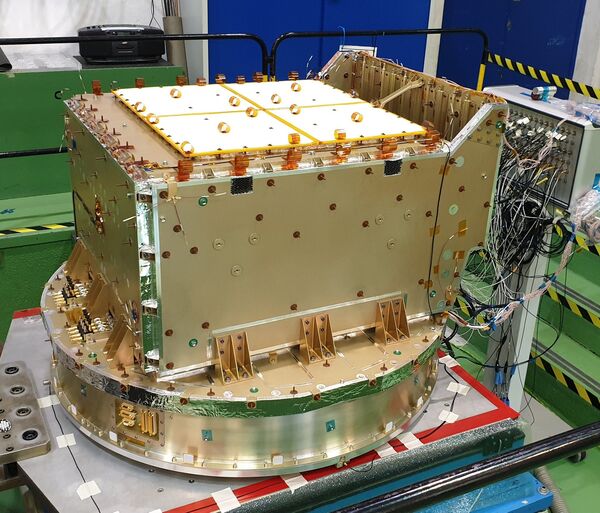
Airbus presents ground-breaking technology for EUTELSAT QUANTUM
"Airbus, ESA and Eutelsat have presented the new ground breaking multibeam active antenna payload today at Airbus in Madrid. Airbus’ ELSA+ (ELectronically Steerable Antenna+) is a first for commercial satellite communications in Europe. The versatility of its performance represents a step change for communications satellites with a spacecraft able for the first time to adapt to the customers’ business cases as and when needed by means of software control. The electronically steerable reception antenna, works in Ku-band with eight independent reconfigurable beams. This inherent flexibility enables the operator to reconfigure the radio frequency beams over the coverage zone, allowing for an unprecedented flexibility in multimedia and broadcasting services. In addition, these capabilities can be implemented on each beam either independently or simultaneously including hop up to several tens of predefined different configurations per beam (beam hopping)." [...]

MediaTek and Intel Partner to Bring 5G Connectivity to the Next Generation of PCs
"MediaTek announces 5G modem optimized for key laptop segments. MediaTek today announced it is partnering with Intel to bring MediaTek’s new 5G modem to PCs. Through this partnership, Intel has been working with MediaTek on the 5G solution for deployment in key consumer and commercial laptop segments. MediaTek is developing the 5G modem and working with partners to manufacture the solution. Dell and HP are expected to be among the first original equipment manufacturers (OEMs) to deliver laptops powered by Intel and MediaTek’s 5G solution. The first rollout of devices is expected for early 2021." [...]
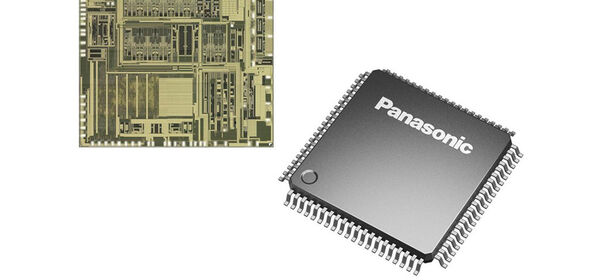
Announcement of the Acquisition of the Semiconductor Business from Panasonic
"Nuvoton Technology Corporation (TSEC:4919, herein “Nuvoton”) announced today that it has entered into a Stock and Asset Purchase Agreement with Panasonic Corporation (TSE:6752, herein “Panasonic”) under which Nuvoton will acquire the semiconductor business of Panasonic mainly operated by Panasonic Semiconductor Solutions., Ltd. (herein “PSCS”) in an all-cash transaction. The transaction has been approved by the Board of Directors of Nuvoton. PSCS, located in Nagaokakyo City, Kyoto, is a leading global supplier of semiconductor devices and solutions with products that focus on “Sensing” technologies such as Image Sensors, Image / Digital Signal Processors, “Microcontroller” technologies such as MCU, IC Card, Battery Management, Power Management and ”Component” technologies such as MOSFET, RF-GaN and Laser Diode. The acquisition of the semiconductor business mainly operated by PSCS will generate greater value for customers and shareholders of both companies, and will: - Increase Nuvoton’s presence in the global semiconductor industry through greater scale and volume of semiconductor solutions; - Position Nuvoton well to capture secular growth trends in the electrification and automation of automotive and industrial fields; - Broaden Nuvoton’s distribution channels and customer base to explore cross-selling opportunities; and - Strengthen Nuvoton’s technology platform via deeper R&D resources and a broader intellectual property portfolio. This transaction, which is expected to close by June 2020, is subject to certain closing conditions including obtaining required regulatory and certain other approvals and consents in the relevant jurisdictions. " [...]
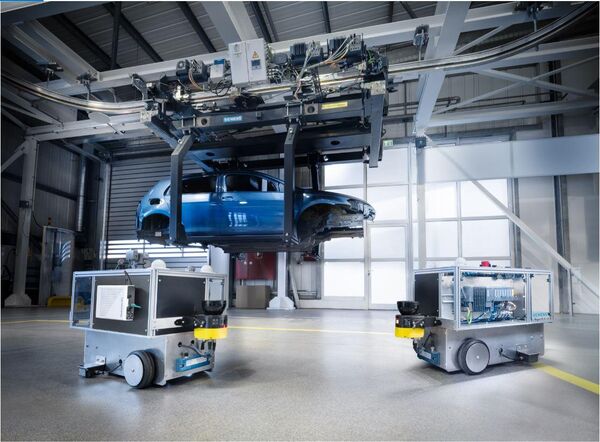
Qualcomm Technologies and Siemens set up the first 5G private standalone network in an industrial environment using the 3.7-3.8GHz band
"Qualcomm Technologies, Inc. and Siemens have setup a joint proof-of-concept project at the Siemens Automotive Test Center in Nuremberg, Germany, demonstrating the first private 5G standalone (SA) network in a real industrial environment using the 3.7-3.8GHz band. Qualcomm Technologies is providing the 5G test network and 5G industrial test devices that run on our foundational 5G technologies, and Siemens is supplying industrial end-devices like automated guided vehicles (AGV). The 5G private standalone network proof-of-concept at the Siemens Automotive Test Center enables Siemens and Qualcomm Technologies to test technologies, solve problems, and come up with solutions for the future of private wireless applications in industrial settings. Qualcomm Technologies set up 5G industrial test devices along with a 5G standalone test network that includes a 5G core network and 5G base station with remote radio head. Siemens provided the actual industrial setup including Simatic control systems and IO devices. “We are excited to announce our 5G private network proof-of-concept collaboration project with Siemens." [...]
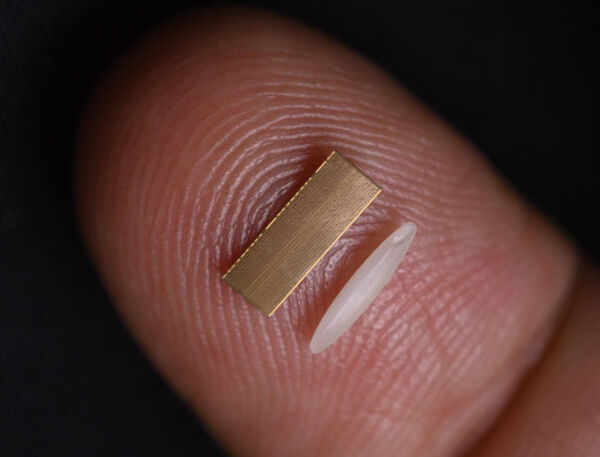
Tiny Intel EMIB Helps Chips ‘Talk’ with Each Other
"Most chips in today’s smartphones, computers and servers are comprised of multiple smaller chips invisibly sealed inside one rectangular package. How do these multiple chips — often including CPU, graphics, memory, IO and more — communicate? An Intel innovation called EMIB (embedded multi-die interconnect bridge) is a complex multi-layered sliver of silicon no bigger than a grain of rice. It lets chips fling enormous quantities of data back and forth among adjoining chips at blinding speeds: several gigabytes per second. Today, Intel EMIBs speed the flow of data inside nearly 1 million laptops and field programmable gate array devices worldwide. That number will soon soar and include more products as EMIB technology enters the mainstream." [...]
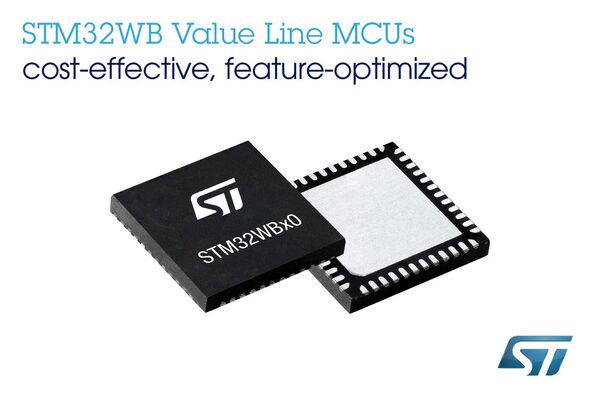
New STM32WB Wireless Microcontrollers from STMicroelectronics Delivered in a New Affordable Value Line
"STM32WB50* Value Line wireless microcontrollers (MCUs) from STMicroelectronics are a full and pin-compatible derivative of the STM32WB55 System-on-Chip, created to serve cost-sensitive connected devices that need to support Bluetooth® 5.0, ZigBee® 3.0, or OpenThread. The devices offer a good link budget from 100dB in Bluetooth 5.0 mode up to 104dB in 802.15.4 mode. New STM32WB Wireless Microcontrollers from STMicroelectronics Delivered in a New Affordable Value Line With the Arm® Cortex®-M4 to handle the user-application software and a Cortex-M0+ to run the radio subsystem including radio stack and security, the STM32WB50 is the best fit for developers seeking radio and application isolation for security reasons or real-time application constraints. The STM32WB50 combines strong security with Value Line affordability. An AES-256 as well as other basic security features are on board to ensure application robustness. The device has 1MByte of Flash and 128Kbyte of RAM and allows Over-The-Air (OTA) updates for the radio stack." [...]
Ciência e Tecnologia
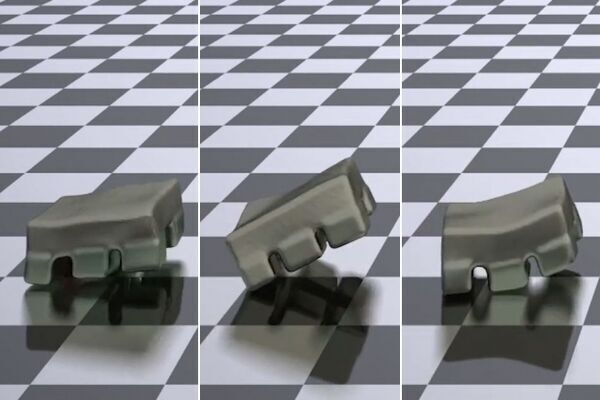
How to design and control robots with stretchy, flexible bodies
"Optimizing soft robots to perform specific tasks is a huge computational problem, but a new model can help. MIT researchers have invented a way to efficiently optimize the control and design of soft robots for target tasks, which has traditionally been a monumental undertaking in computation. Soft robots have springy, flexible, stretchy bodies that can essentially move an infinite number of ways at any given moment. Computationally, this represents a highly complex “state representation,” which describes how each part of the robot is moving. State representations for soft robots can have potentially millions of dimensions, making it difficult to calculate the optimal way to make a robot complete complex tasks. At the Conference on Neural Information Processing Systems next month, the MIT researchers will present a model that learns a compact, or “low-dimensional,” yet detailed state representation, based on the underlying physics of the robot and its environment, among other factors." [...]

New antenna tech to equip ceramic coatings with heat radiation control
"The gas turbines powering aircraft engines rely on ceramic coatings that ensure structural stability at high temperatures. But these coatings don’t control heat radiation, limiting the performance of the engine. Researchers at Purdue University have engineered ceramic “nanotubes” that behave as thermal antennas, offering control over the spectrum and direction of high-temperature heat radiation. The work is published in Nano Letters, a journal by the American Chemical Society. An illustration of the ceramic nanotubes will be featured as the journal’s supplementary cover in a forthcoming issue. “By controlling radiation at these high temperatures, we can increase the lifetime of the coating." [...]
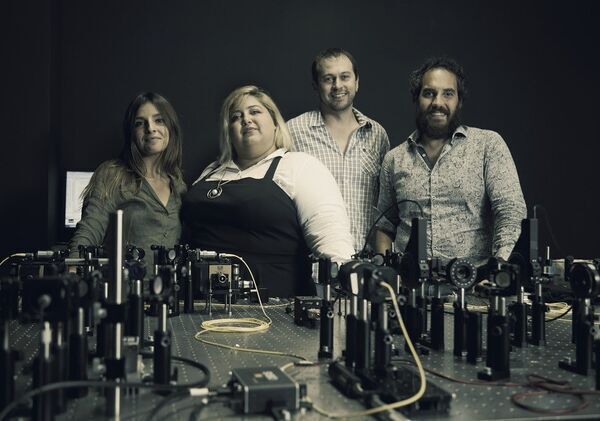
Quantum Light Improves Sensitivity of Biological Measurements
"New approach combines quantum physics and biology to improve enzyme activity measurements. In a new study, researchers showed that quantum light can be used to track enzyme reactions in real time. The work brings together quantum physics and biology in an important step toward the development of quantum sensors for biomedical applications. The complex molecules known as enzymes are responsible for many processes inside our bodies. However, they can be difficult to study with optical approaches because too much light will reduce their activity or even stop it altogether. In The Optical Society (OSA) journal Optics Express, a multidisciplinary group of researchers showed that light controlled at the single-photon, or quantum, level can allow accurate measurements without disrupting enzymatic activity." [...]

New Artificial Intelligence System Automatically Evolves to Evade Internet Censorship
"Internet censorship by authoritarian governments prohibits free and open access to information for millions of people around the world. Attempts to evade such censorship have turned into a continually escalating race to keep up with ever-changing, increasingly sophisticated internet censorship. Censoring regimes have had the advantage in that race, because researchers must manually search for ways to circumvent censorship, a process that takes considerable time. New work led by University of Maryland computer scientists could shift the balance of the censorship race. The researchers developed a tool called Geneva (short for Genetic Evasion), which automatically learns how to circumvent censorship. Tested in China, India and Kazakhstan, Geneva found dozens of ways to circumvent censorship by exploiting gaps in censors' logic and finding bugs that the researchers say would have been virtually impossible for humans to find manually." [...]

Quantum computers learn to mark their own work
"Quantum computers can potentially answer questions beyond the capabilities of classical computing – but their answers might not be reliable University of Warwick scientists have developed a protocol for quantum computers to measure how close their answers are to the correct ones Checking whether these answers are correct using classical methods is extremely resource-intensive Could be used in confirming whether a quantum computer has outperformed classical computers, so-called quantum supremacy A new test to check if a quantum computer is giving correct answers to questions beyond the scope of traditional computing could help the first quantum computer that can outperform a classical computer to be realised. By creating a protocol that allows a quantum computer to check its own answers to difficult problems, the scientists from the University of Warwick have provided a means to confirm that a quantum computer is working correctly without excessive use of resources. Samuele Ferracin, Theodoros Kapourniotis and Dr Animesh Datta from the University’s Department of Physics have recently tackled this problem in a paper for The New Journal of Physics, published today (18 November). The researchers have developed a protocol to quantify the effects of noise on the outputs of quantum computers. Noise is defined as anything that affects a quantum machine’s hardware but is beyond the user’s control, such as fluctuations in temperature or flaws in the fabrication. This can affect the accuracy of a quantum computer’s results." [...]

Economizing on iridium
"Iridium is an ideal catalyst for the electrolytic production of hydrogen from water – but it is extremely expensive. But now a new kind of electrode made of highly porous material does an excellent job with just a hint of iridium. Today, the royal road to the effective electrolysis of water for the production of hydrogen gas in so called proton exchange membrane (PEM) electrolyzers is to reduce the amount of catalytically highly active but scare nobel metal iridium and at the same time maintain the hydrogen output. In this type of electrolyzer cell the hydrogen ions migrate via a proton exchange membrane from the oxygen producing anode to the hydrogen producing cathode. The membrane-based technique offers many advantages. The catalyst coated membrane itself is very thin, which makes the electrolytic cell itself small and more versatile, and the absence of a liquid electrolyte means that the whole system requires virtually no maintenance." [...]
Stretchable, degradable semiconductors
"To seamlessly integrate electronics with the natural world, materials are needed that are both stretchable and degradable –– for example, flexible medical devices that conform to the surfaces of internal organs, but that dissolve and disappear when no longer needed. However, introducing these properties to electronics has been challenging. Now, researchers reporting in ACS Central Science have developed stretchable, degradable semiconductors that could someday find applications in health and environmental monitoring. Semiconductors, which are essential components of almost all computers and electronic devices, have properties somewhere between conductors and resistors. Most semiconductors are currently made of silicon or other rigid inorganic materials. Scientists have tried making flexible, degradable semiconductors using different approaches, but the products either didn’t break down completely or had reduced electrical performance when stretched." [...]
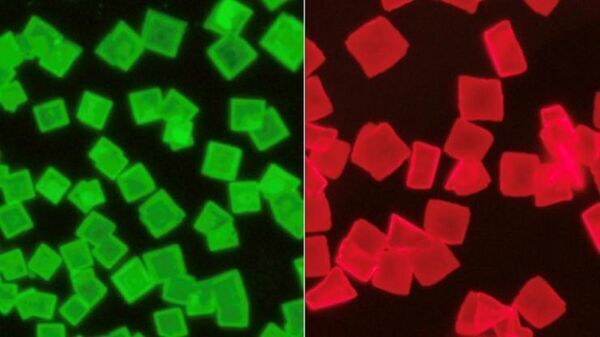
New crystal structure improves stability, safety of hybrid perovskite materials
"Harnessing the sun’s rays to produce solar power is an expanding industry with positive environmental impacts. As sunlight reaches semiconducting materials, it is converted into electricity through a photovoltaic system of solar cells, generating renewable, clean energy that can run everything from small electronic devices to electric lighting to race cars. One growing area in solar power research is perovskite materials, which have a unique structure that makes possible low-cost, efficient photovoltaic cells used to convert the harvested solar energy into useful electricity for homes, businesses, and military. These perovskite solar cells, or PSCs, are one of the fastest developing solar technologies, with broad applications due to their unique optical and electronic properties. PSCs combine organic and inorganic materials, and can be built using low-cost manufacturing methods, making production inexpensive and efficient. Despite these advantages, PSC materials have some limiting characteristics." [...]
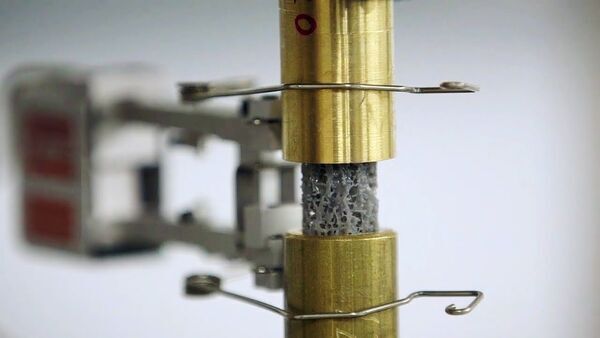
Bone breakthrough may lead to aerospace advances
"Cornell researchers have made a new discovery about how seemingly minor aspects of the internal structure of bone can be strengthened to withstand repeated wear and tear, a finding that could help treat patients suffering from osteoporosis. It could also lead to the creation of more durable, lightweight materials for the aerospace industry. The team's paper, "Bone-Inspired Microarchitectures Achieve Enhanced Fatigue Life," was published Nov. 18 in the Proceedings of the National Academy of Sciences. Co-authors include Cornell doctoral students Cameron Aubin and Marysol Luna; postdoctoral researcher Floor Lambers; Pablo Zavattieri and Adwait Trikanad at Purdue University; and Clare Rimnac at Case Western Reserve University. For decades, scientists studying osteoporosis have used X-ray imaging to analyze the structure of bones and pinpoint strong and weak spots. Density is the main factor that is usually linked to bone strength, and in assessing that strength, most researchers look at how much load a bone can handle all at once." [...]
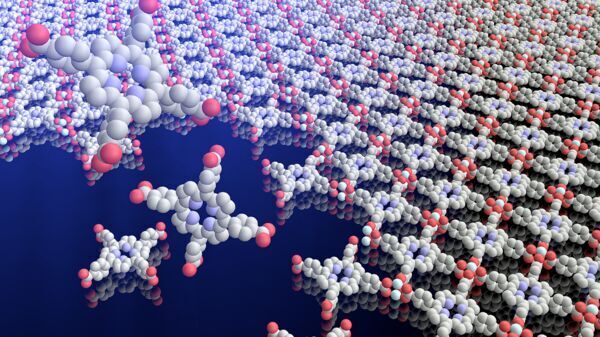
Invention of teeny-tiny organic films could enable new electronics
"UChicago scientists’ breakthrough creates films just a few atoms thick The first cell phone, released in 1983, was the size of a brick and weighed two-and-a-half pounds. The newest Apple Watch, released this fall, weighs 1.1 ounces. These kind of technological leaps have been made possible by finding new and inventive ways of combining materials, which can pack more information and circuitry into smaller and smaller packages. In a first, scientists at the University of Chicago, in collaboration with researchers at Cornell University and Argonne National Laboratory, have discovered an easy, efficient way to grow extremely thin films of organic materials. The findings, published Nov. 7 in Science, could be a stepping-stone to future electronics or technologies with new abilities. Scientists have known for a long time how to make extremely thin layers—down to a few atoms thick—out of inorganic materials." [...]

Super-efficient wing takes off
"In a joint effort by the Technical University of Munich (TUM) and the German Aerospace Center (DLR), researchers have successfully developed new technologies for lighter aircraft wings that are still extremely stable. These innovative wings could soon make flying both greener and more cost-efficient. Known as aeroelastic wings, on Tuesday they made their successful first flight at the airfield in Oberpfaffenhofen. Wings with a wider wingspan and less weight also have less air resistance and better energy-efficiency. Optimized lift behavior could save kerosene and thus reduce both emissions and costs. The limiting factor for building wings like these is the aerodynamic phenomenon known as "flutter"." [...]
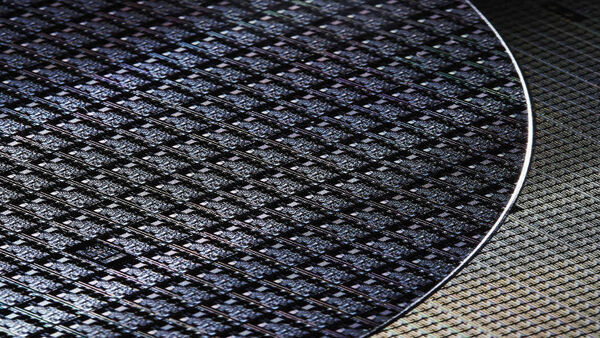
Bipolar-Zener Combo Takes On CMOS
"A collaboration between a British startup and a British foundry has produced test devices of a new transistor type that can be produced with just three weeks’ lead time, as it requires only eight mask steps. By comparison, the CMOS process typically requires many more mask steps and takes around 15 weeks, said the developers of the technology, Search For the Next (SFN) and Semefab. The Bizen process is named for its combination of a bipolar junction with concepts from a Zener diode. It uses the quantum tunnelling effect to eliminate the resistor, and all metal layers, from a traditional bipolar transistor. The transistor’s input is via a quantum tunnelling connection and the device has two identical outputs, allowing for AC signals (anodes 1 and 2; analogous to collector and emitter in a bipolar junction transistor or BJT). The transistor is normally on; bringing the tunnel to the highest potential turns it off." [...]
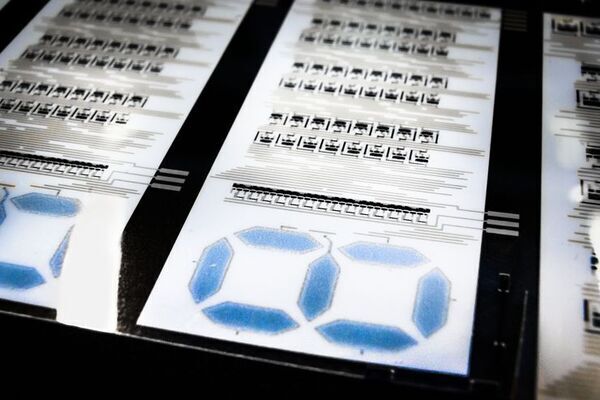
Large integrated circuits produced in printing press
"Researchers at Linköping University and RISE, Campus Norrköping, have shown for the first time that it is possible to print complete integrated circuits with more than 100 organic electrochemical transistors. The result has been published in Nature Communications. “This is a decisive step for a technology that was born at Linköping University just over 17 years ago. The result shows that we are again leading the field, thanks to the close collaboration between basic research at the Laboratory of Organic Electronics, LOE, and applied research at RISE”, says Magnus Berggren, professor of organic electronics and director of LOE. “The advantage we have here is that we do not need to mix different manufacturing methods: everything is done by screen printing, and in relatively few processing steps. The key is ensuring that the different layers end up in exactly the right place”, says Peter Andersson Ersman, researcher in printed electronics at the RISE research institute." [...]

Wind energy in need of further development
"Researchers from DTU Wind Energy and an international group of colleagues are highlighting the need for further scientific and innovation breakthroughs within wind energy. The total global capacity of installed wind turbines have increased tenfold since 2005 as per an estimation from the World Wind Energy Association. In 2005, the total global capacity was 59 Gigawatt rising to almost 600 GW in 2018. For the past five years, new capacity of roughly 50 GW have been added every year. One would think that this trajectory is ensuring that wind energy will become a primary source of sustainable, low-cost energy in the future. However, the wind turbines installed by the end of 2018 only covered close to 6% of the global electricity demand." [...]
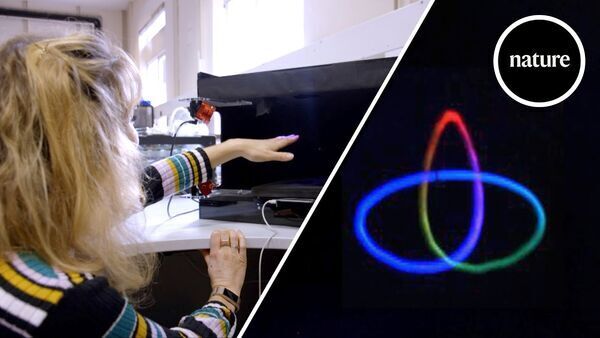
Calling Princess Leia: How the out-of-this-galaxy Star Wars hologram just became a step closer to reality
"Academics at the University of Sussex have come the closest yet to recreating one of the most iconic of Star Wars technology by developing for the first time holograms that can be seen by the naked eye as well as heard and felt. While not yet able to transmit a 3-D distress call from Princess Leia, the Multimodal Acoustic Trap Display (MATD) is capable of showing a coloured butterfly gently flapping in mid-air, emojis and other images which are visible without the need for VR or AR headsets. Lead author Dr Ryuji Hirayama, a JSPS scholar and Rutherford Fellow at the University of Sussex, said: “Our new technology takes inspiration from old TVs which use a single colour beam scanning along the screen so quickly that your brain registers it as a single image. Our prototype does the same using a coloured particle that can move so quickly anywhere in 3D space that the naked eye sees a volumetric image in mid-air.” The MATD uses ultrasound to trap a particle and illuminate it with red, green, and blue light to control its colour as it quickly scans through an open space to reveal the illusion of volumetric content. The prototype scans the content in less than the 0.1 second that the eye takes to integrate different light stimuli under a single shape. As well as visual content, the prototype developed by a team at the University of Sussex’s School of Engineering and Informatics can also blast out a chorus of Queen or create a tactile button in mid-air through the use of ultrasound alone." [...]
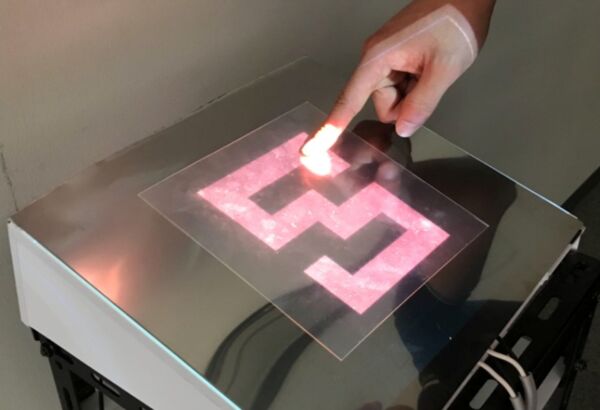
Novel tactile display using computer-controlled surface adhesion
"A group of researchers at Osaka University developed a novel two-dimensional (2D) graphical tactile display to which one-dimensional (1D) adhesive information could be added by controlling adhesion of designated portions of the display surface. (Fig.1) Their research results were presented at SIGGRAPH ASIA 2019 Emerging Technologies, which was held in Australia from November 18 through November 20, 2019. The research team received the BEST DEMO VOTED BY COMMITTEE AWARD. With conventional techniques, it was impossible to perform dynamic and interactive control by changing the shape or friction coefficient of an area on the surface of an electronic device, such as a paper-like screen, in order to enhance its operability. Thus, researchers have made efforts to present further information by using visual presentation that can also deliver other sensory (tactile) content. In the entertainment industry, such as in video games, displays that give players a sense of temperature or shock have been proposed so that they can feel as if they were actually in the scene of a game." [...]
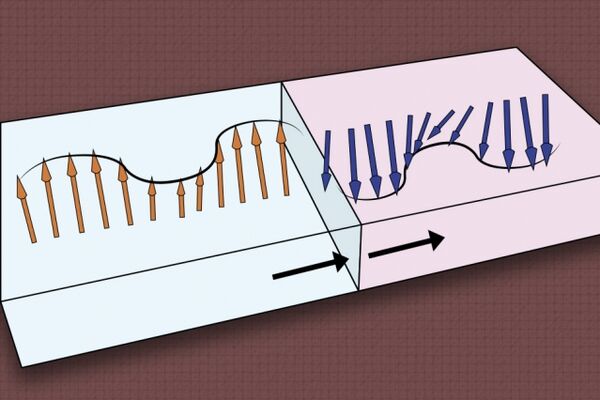
Toward more efficient computing, with magnetic waves
"Circuit design offers a path to “spintronic” devices that use little electricity and generate practically no heat. MIT researchers have devised a novel circuit design that enables precise control of computing with magnetic waves — with no electricity needed. The advance takes a step toward practical magnetic-based devices, which have the potential to compute far more efficiently than electronics. Classical computers rely on massive amounts of electricity for computing and data storage, and generate a lot of wasted heat. In search of more efficient alternatives, researchers have started designing magnetic-based “spintronic” devices, which use relatively little electricity and generate practically no heat. Spintronic devices leverage the “spin wave” — a quantum property of electrons — in magnetic materials with a lattice structure." [...]
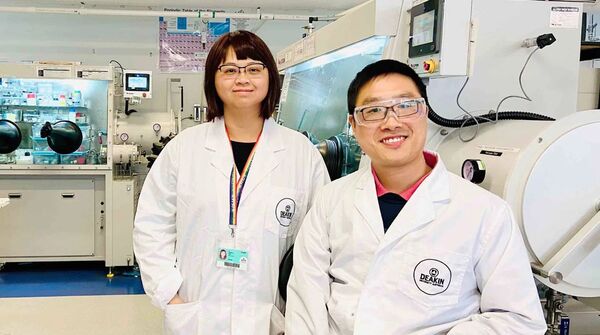
Breakthrough paves path for a future free of batteries catching fire
"Deakin materials scientists have proven that liquid solvent-free solid state batteries can easily be made, paving the way for a future free from batteries catching fire or exploding if they get too hot. Research fellows at Deakin's Institute for Frontier Materials Dr Fangfang Chen and Dr Xiaoen Wang say their discovery means that lithium-ion batteries found in everyday items like mobile phones, computers and vehicles would no longer pose a fire risk because the highly volatile liquid electrolyte currently used in them would be replaced with a solid polymer material. "This investigation has the potential to underpin some very significant work to improve batteries at two key points," Dr Wang said. "Our findings suggest that next generation batteries will be much safer and have exceptionally better performance. From what we've discovered, this electrolyte will allow us to use a lithium metal anode, which could see future batteries last twice as long as they currently do with one charge. Alternatively, batteries could end up half of their size and weight without compromising performance time."" [...]
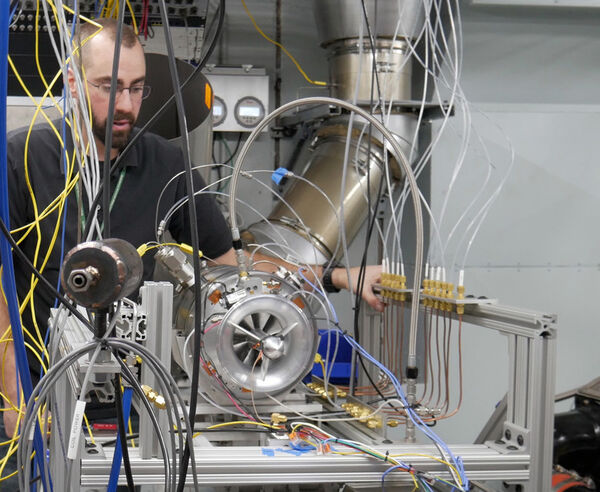
AFRL tests in-house, rapidly developed small engine
"The Air Force Research Laboratory demonstrated a new and ultra-responsive approach to turbine engine development with the initial testing of the Responsive Open Source Engine (ROSE) on Nov. 6, 2019, at Wright-Patterson Air Force Base. The Aerospace Systems Directorate’s ROSE is the first turbine engine designed, assembled, and tested exclusively in-house. The entire effort, from concept initiation to testing, was executed within 13 months. This program responds to Air Force’s desire for rapid demonstration of new technologies and faster, less expensive prototypes. “We decided the best way to make a low-cost, expendable engine was to separate the development costs from procurement costs,” said Frank Lieghley, Aerospace Systems Directorate Turbine Engine Division senior aerospace engineer and project manager. He explained that because the design and development were conducted in-house, the Air Force owns the intellectual property behind it." [...]
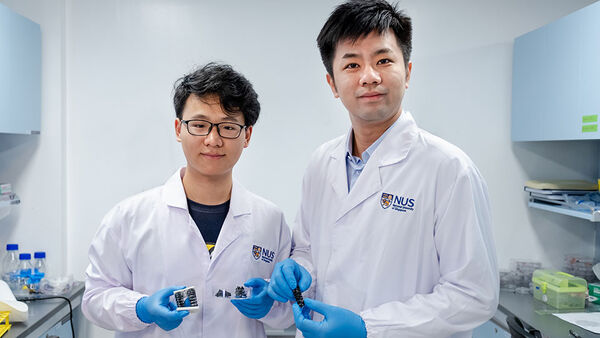
NUS researchers create new metallic material for flexible soft robots
"‘Origami robots’ are state-of-the-art soft and flexible robots that are being tested for use in various applications including drug delivery in human bodies, search and rescue missions in disaster environments and humanoid robotic arms. Because these robots need to be flexible, they are often made from soft materials such as paper, plastic and rubber. To be functional, sensors and electrical components are often added on top, but these add bulk to the devices. Now, a team of NUS researchers has developed a novel method of creating a new metal-based material for use in these soft robots. Combining metals such as platinum with burnt paper (ash), the new material has enhanced capabilities while maintaining the foldability and lightweight features of traditional paper and plastic. In fact, the new material is half as light as paper, which also makes it more power efficient." [...]
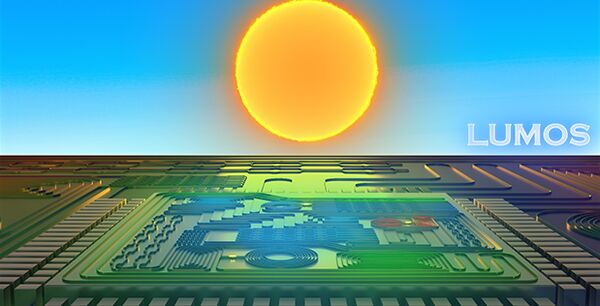
Powering Future Optical Microsystems with Chip-Scale Integrated Photonics
"Program seeks to develop photonic integrated circuit platforms that incorporate on-chip optical gain for disruptive optical microsystems Lasers are essential to many fields – ranging from optical communications and remote sensing, to manufacturing and medicine. While the semiconductor laser was first demonstrated nearly 60 years ago, advances in diode lasers and access to semiconductor fabrication techniques have enabled continued innovation and miniaturization of the technology. Photonic integrated circuits (PICs), which combine many photonic elements onto a single chip, have also transformed the way lasers and other optical systems are engineered, creating improvements in size, weight, and power (SWaP), system performance, and enabling new functionality. Despite these advances, a number of obstacles still hamper the proliferation of optical systems for defense and commercial applications. Today, PICs take several forms and are defined by the materials used to create the integrated device platform. While the vast silicon electronics manufacturing ecosystem has established silicon photonics as the premier platform for the integration of thousands of high-performance passive components on a single chip, fundamental material constraints preclude efficient generation of light, or optical gain, using on-chip components." [...]
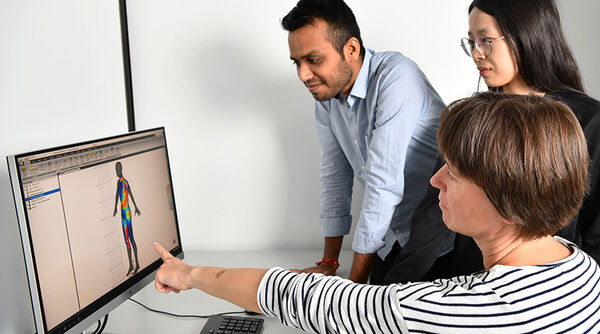
Software to speed up clothing development
"Whether for sports, at work or in the living room – depending on activity and environment, our clothing has to meet different demands. Empa scientists have developed a model that predicts how well a given garment will keep us warm. The crucial factor is the air gap between our body and the outermost layer of clothing. In winter, it can look sunny and warm. But as soon as we are exposed to the wind, we start freezing. If our clothing is not adapted to the conditions, we quickly feel uncomfortable." [...]
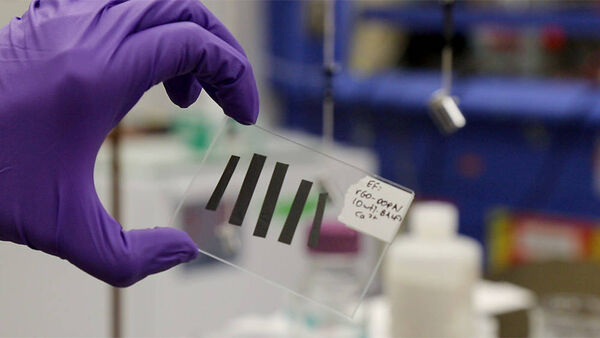
New electrodes could increase efficiency of electric vehicles and aircraft
"The rise in popularity of electric vehicles and aircraft presents the possibility of moving away from fossil fuels toward a more sustainable future. While significant technological advancements have dramatically increased the efficiency of these vehicles, there are still several issues standing in the way of widespread adoption. One of the most significant of these challenges has to do with mass, as even the most current electric vehicle batteries and supercapacitors are incredibly heavy. A research team from the Texas A&M University College of Engineering is approaching the mass problem from a unique angle. Most of the research aimed at lowering the mass of electric vehicles has focused on increasing the energy density, thus reducing the weight of the battery or supercapacitor itself. However, a team led by Dr. Jodie Lutkenhaus, professor in the Artie McFerrin Department of Chemical Engineering, believes that lighter electric vehicles and aircraft can be achieved by storing energy within the structural body panels." [...]
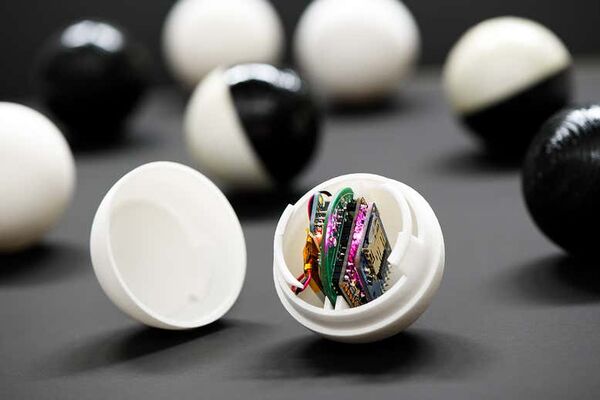
Swarms of golf ball-sized robots could detect leaks in the sewers
"Swarms of floating robots could help map underground pipe networks and detect leaks and blockages in plumbing. Peter Baltus at Eindhoven University of Technology in the Netherlands and his colleagues have developed golf ball-sized sensors that can collect information as they float through pipes. Each robot contains a microprocessor, sensor, memory boards and a battery. They can be programmed to detect sound, temperature, pressure, acceleration, rotation and magnetic fields. To save power, a sensor can be activated by a sudden change in conditions, such as hissing sounds associated with water escaping, or increased rotation, which could be a sign of turbulent water flow. The robot would then increase the rate at which it takes measurements." [...]

Researchers reach milestone in quantum standardization
"Researchers at the University of Waterloo have developed a method that could pave the way to establishing universal standards for measuring the performance of quantum computers. The new method, called cycle benchmarking, allows researchers to assess the potential of scalability and to compare one quantum platform against another. “This finding could go a long way toward establishing standards for performance and strengthen the effort to build a large-scale, practical quantum computer,” said Joel Wallman, an assistant professor at Waterloo’s Faculty of Mathematics and Institute for Quantum Computing. “A consistent method for characterizing and correcting the errors in quantum systems provides standardization for the way a quantum processor is assessed, allowing progress in different architectures to be fairly compared. Cycle benchmarking provides a solution that helps quantum computing users determine the comparative value of competing hardware platforms and increase the capability of each platform to deliver robust solutions for their applications of interest. The breakthrough comes as the quantum computing race is rapidly heating up, and the number of cloud quantum computing platforms and offerings is quickly expanding." [...]
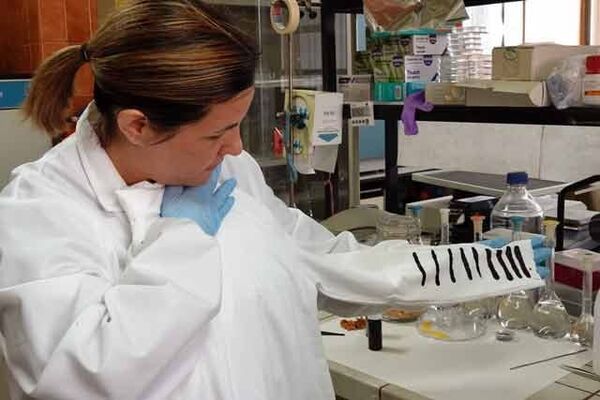
Hey Design A Shirt That Produces Electricity With The Temperature Difference Between The Body And The Environment
"The ‘e-textile’ prototype uses sustainable and low-cost materials such as tomato skin Researchers at the Faculty of Science of the University of Malaga have designed a ‘low cost’ shirt capable of producing electricity due to the difference in body temperature and the environment. This is the ‘e-textile’ prototype, developed together with the Italian Institute of Technology of Genoa (IIT), based on sustainable methods and low-cost materials such as tomato skin. “Until now, for the creation of electronic devices, metals were the most used chemical elements. With this project we go one step further and, using lightweight, more affordable and less toxic materials, we have also managed to generate electricity, ”explains José Alejandro Heredia, one of the authors of this work. The formula is very simple: water and ethanol – a type of organic alcohol – derived from tomato skin and carbon nanoparticles. A solution that, according to experts, when heated, penetrates and adheres to cotton, thereby achieving electrical properties such as those generated by tellurium, germanium or lead, but from biodegradable materials." [...]
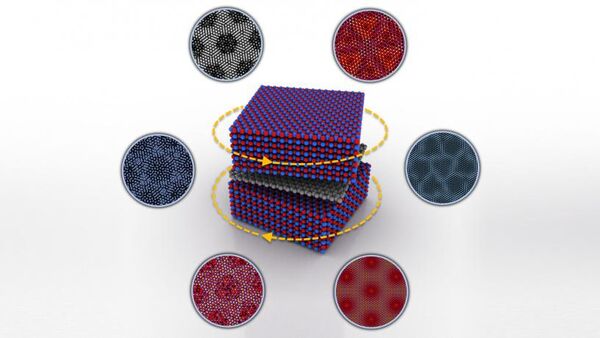
Breaking (and Restoring) Graphene’s Symmetry in a Twistable Electronics Device
"Columbia researchers invent a new way to tune the properties of 2D materials by adjusting the twist angle between them; technology enables the development of nanoelectromechanical sensors with applications in astronomy, medicine, search and rescue, and more. A recent study from the labs of James Hone (mechanical engineering) and Cory Dean (physics) demonstrates a new way to tune the properties of two-dimensional (2D) materials simply by adjusting the twist angle between them. The researchers built devices consisting of monolayer graphene encapsulated between two crystals of boron nitride and, by adjusting the relative twist angle between the layers, they were able to create multiple moiré patterns. Moiré patterns are of high interest to condensed matter physicists and materials scientists who use them to change or generate new electronic material properties. These patterns can be formed by aligning boron nitride (BN, an insulator) and graphene (a semimetal) crystals. When these honeycomb lattices of atoms are close to alignment, they create a moiré superlattice, a nanoscale interference pattern that also looks like a honeycomb." [...]
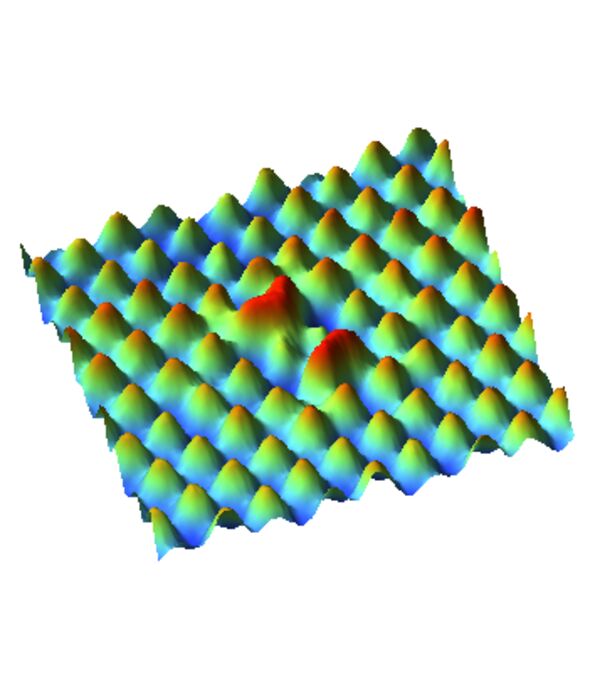
Princeton scientists discover surprising quantum effect in an exotic superconductor
"An international team led by researchers at Princeton University has directly observed a surprising quantum effect in a high-temperature iron-containing superconductor. Superconductors conduct electricity without resistance, making them valuable for long-distance electricity transmission and many other energy-saving applications. Conventional superconductors operate only at extremely low temperatures, but certain iron-based materials discovered roughly a decade ago can superconduct at relatively high temperatures and have drawn the attention of researchers. Exactly how superconductivity forms in iron-based materials is something of a mystery, especially since iron’s magnetism would seem to conflict with the emergence of superconductivity. A deeper understanding of unconventional materials such as iron-based superconductors could lead eventually to new applications for next-generation energy-saving technologies. The researchers probed the behavior of iron-based superconductors when impurities – namely atoms of cobalt – are added to explore how superconductivity forms and dissipates." [...]

Researchers create blueprint for ‘quantum battery’ that doesn’t lose charge
"Scientists from the universities of Alberta and Toronto developed a blueprint for a new quantum battery that doesn’t leak charge. “A quantum battery is a tiny, nano-size battery meant to be used for applications on the nano scale,” explained U of A chemist Gabriel Hanna, who was principal investigator on the study. He said the research provides a theoretical demonstration that creating a loss-free quantum battery is possible—offering an advantage over previously proposed quantum batteries. “The batteries that we are more familiar with—like the lithium-ion battery that powers your smartphone—rely on classical electrochemical principles, whereas quantum batteries rely solely on quantum mechanics,” Hanna noted. He said the batteries may become an important component in many quantum devices—able to power quantum computers, for example—and in practice, they could be built using current solid-state technologies. To realize their idea, the research team considered an open quantum network model with high structural symmetry as a platform for storing excitonic energy—energy harnessed when an electron absorbs a sufficiently energetic photon of light.Using this model, they showed it is possible to store energy without any loss, despite being open to an environment." [...]

Self-assembling system uses magnets to mimic specific binding in DNA
"Sometimes it’s best to let the magnets do all the work. A team led by physics professors Itai Cohen and Paul McEuen is using the binding power of magnets to design self-assembling systems that potentially can be created in nanoscale form. Their paper, “Magnetic Handshake Materials as A Scale-Invariant Platform for Programmed Self-Assembly,” published Nov. 21 in Proceedings of the National Academy of Sciences. To make small systems – such as miniature machines, gels and metamaterials – that essentially build themselves, the researchers took inspiration from DNA origami, in which atomic-scale DNA strands can be folded into two- and three-dimensional structures through a process called complementary base pairing, where specific nucleotides bind to one another: A to T and G to C. Rather than relying on atomic bonds, the team was drawn to another form of attraction: magnetics. Here, the attraction and repulsion between multiple magnets can serve as a kind of intelligent connection, like a handshake. Magnetic interactions also make for strong, versatile bonds that aren’t easily disrupted by thermal effects." [...]
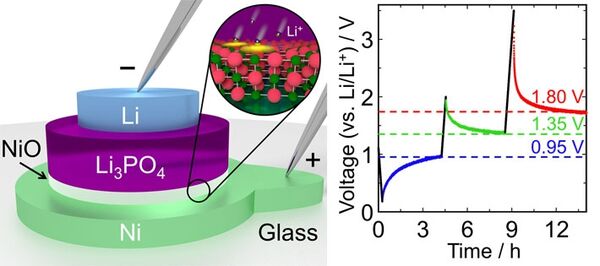
Small, fast, and highly energy-efficient memory device inspired by lithium-ion batteries
"Scientists at the Tokyo Institute of Technology (Tokyo Tech) and the University of Tokyo (UTokyo) developed a new three-valued memory device inspired by solid lithium-ion batteries. The proposed device, which has an extremely low energy consumption, may be key for the development of more energy-efficient and faster random-access memories (RAMs), which are ubiquitous in modern computers. Virtually all digital devices that perform any sort of processing of information require not only a processing unit, but also a quick memory that can temporarily hold the inputs, partial results, and outputs of the operations performed. In computers, this memory is referred to as dynamic random-access memory, or DRAM. The speed of DRAM is very important and can have a significant impact in the overall speed of the system. In addition, lowering the energy consumption of memory devices has recently become a hot topic to achieve highly energy-efficient computing." [...]
Precise and printable silicon nanoparticles
"Silicon nanoparticles dispersed in solution can be positioned by light and printed onto surfaces, or used in applications such as medical imaging and drug delivery. The darling element of electronic devices, silicon can be found in all mobile phones and computers in the form of thin wafers. However, when fabricated into nanoparticles, it has a new set of applications that range from photonics to magnetic resonance imaging. “The typical method of producing nanoparticles in solution, or nanoparticle colloids as we call them, is by chemical synthesis. However, this method isn't yet well developed for silicon nanoparticles of the required nanoparticle dimensions of a few hundred nanometers,” said Arseniy Kuznetsov, Head of the Advanced Optical Technologies department at A*STAR’s Institute of Materials Research and Engineering (IMRE). Currently, laser ablation is how most laboratories produce silicon nanoparticle colloids, but a major drawback is poor control over the resultant nanoparticle sizes." [...]
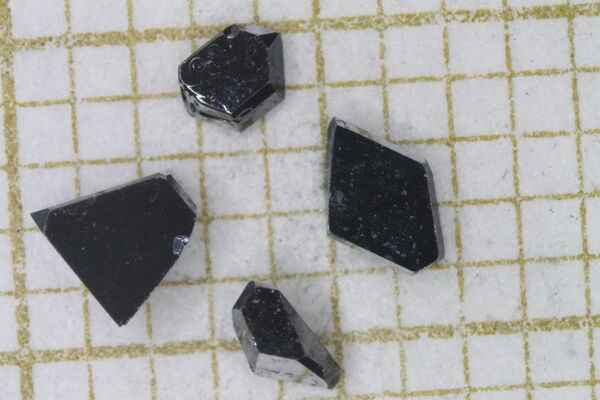
Unboxing a New Spin-Triplet Superconductor
"Nature often reveals itself in surprising ways, so scientists, who study nature, have a lot of opportunities to be surprised. Over the past year and a half, I have been working on UTe2, a simple compound made of two parts, uranium and tellurium, which I discovered is a superconductor. That is, it conducts electricity without resistance under certain conditions. Superconductivity is exciting because it’s almost like a superpower: It can help scientists detect very weak brain activity, accelerate particles to nearly the speed of light, and potentially provide the building blocks for futuristic quantum computers that could solve complex problems our current computers can’t touch. As our newest discovered superconductor, uranium ditelluride keeps surprising me, our research team, and the scientific community. Following what Forrest Gump says, research “is like a box of chocolates; you never know what you’re gonna get.” The story I am going to share about UTe2 is exactly like a box of chocolates, and I hope you enjoy it." [...]
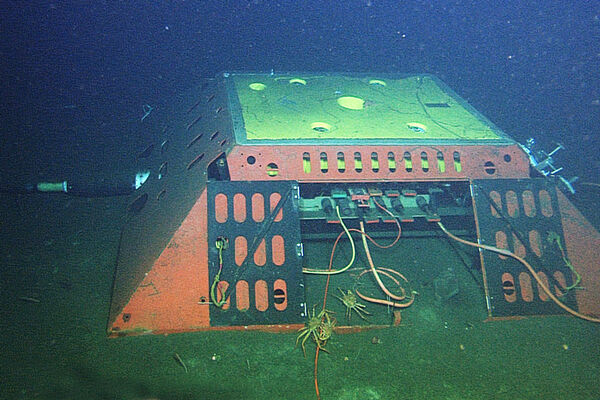
Underwater telecom cables make superb seismic network
"Fiber-optic cables that constitute a global undersea telecommunications network could one day help scientists study offshore earthquakes and the geologic structures hidden deep beneath the ocean surface. In a paper appearing this week in the journal Science, researchers from the University of California, Berkeley, Lawrence Berkeley National Laboratory (Berkeley Lab), Monterey Bay Aquarium Research Institute (MBARI) and Rice University describe an experiment that turned 20 kilometers of undersea fiber-optic cable into the equivalent of 10,000 seismic stations along the ocean floor. During their four-day experiment in Monterey Bay, they recorded a 3.5 magnitude quake and seismic scattering from underwater fault zones. Their technique, which they had previously tested with fiber-optic cables on land, could provide much-needed data on quakes that occur under the sea, where few seismic stations exist, leaving 70% of Earth’s surface without earthquake detectors. “There is a huge need for seafloor seismology. Any instrumentation you get out into the ocean, even if it is only for the first 50 kilometers from shore, will be very useful,” said Nate Lindsey, a UC Berkeley graduate student and lead author of the paper." [...]

Chinese Academy of Sciences Leads Discovery of Unpredicted Stellar Black Hole
"Our Milky Way Galaxy is estimated to contain 100 million stellar black holes – cosmic bodies formed by the collapse of massive stars and so dense even light can’t escape. Until now, scientists had estimated the mass of an individual stellar black hole in our Galaxy at no more than 20 times that of the Sun. But the discovery of a huge black hole by a Chinese-led team of international scientists has toppled that assumption. The team, headed by Prof. LIU Jifeng of the National Astronomical Observatory of China (NAOC) of the Chinese Academy of Sciences, spotted a stellar black hole with a mass 70 times greater than the Sun. The monster black hole is located 15 thousand light-years from Earth and has been named LB-1 by the researchers. The discovery is reported in the latest issue of Nature." [...]
Documentação
A documentação é parte essencial do processo de aprendizagem e a Internet além de artigos interessantes de explorar também tem alguma documentação em formato PDF interessante de ler. Todos os links aqui apresentados são para conteúdo disponibilizado livremente pelo editor do livro.

Retro Gaming with Raspberry Pi
"This 164-page book shows you how to set up a Raspberry Pi to play classic games, and a whole lot more. Build your own portable console, full-size arcade cabinet, and pinball machine with our step-by-step guides. And learn how to program your own games, using Python and Pygame Zero. - Set up your Raspberry Pi for retro gaming - Emulate classic computers and consoles - Learn to program retro-style games - Build a portable console, arcade cabinet, and pinball machine - And much, much more! " [...]
Projetos Maker
Diversos Projetos interessantes.
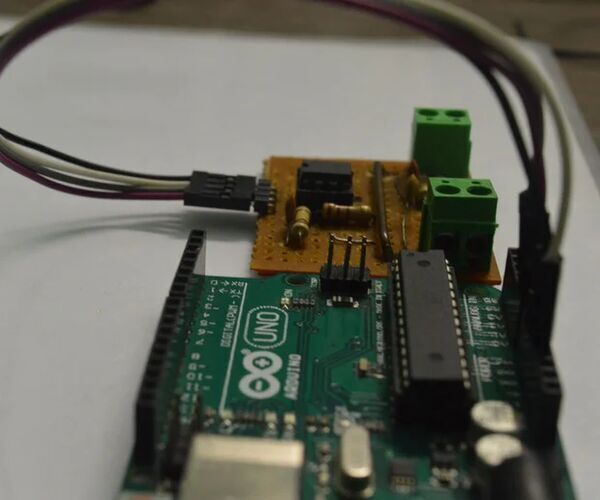
DIY Power Measurement Module for Arduino
"Hello everyone, I hope you are doing great! In this instructable I am going to show you how I made this Power meter/ Wattmeter module for use with an Arduino board. This power meter can calculate the power consumed by and DC Load. Along with power, this module can also give us accurate readings of voltage and current. It can easily measure low voltages (around 2V) and low currents, as low as 50 mA with an error not more than 20mA. The accuracy depends upon the choice of components based upon your requirements." [...]

Crazy Clock 4
"It's a clock with a lot of flashing lights. Features - GPS synchronized timebase. - DS3231 TCXO RTC backup timebase. - Digital date/time display with AM/PM and Day of Week. - Binary time display. - Circular time display." [...]
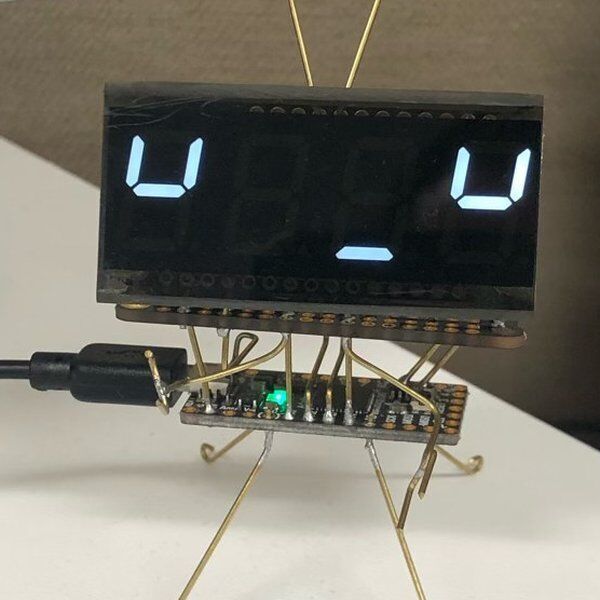
CircuitPython 7-Segment Character Clock
"A desk clock built from a few Adafruit boards & brass rods for structure/connections. A desk clock built from a few Adafruit boards & brass rods for structure/connections. This small clock is actually my second project; it was started and finished while I was intermittently programming another larger clock made with a 16x16 NeoPixel matrix. Apparently clocks are my thing (for now) because I wanted to build useful things and its pretty easy to read a RTC and display the time. I was inspired by Mohit Bhoite's electronic sculpture projects, particularly this one featuring a 7-segment display. I don't have that caliber of soldering or programming skills, but Adafruit's CircuitPython looked like a good way to quickly program a small project and the ItsyBitsy M0 Express had capacitive touch capability to easily provide inputs." [...]

Echo & Reverb Box
"This build is based around a great little reverb module you can get on eBay for under $5. Ive used it now in a couple of projects (listed below) but this time I wanted to have a stand along reverb and echo effects box. You can use this in a whole bunch of different applications from a guitar pedal and Karaoke effects box to an effects module for DJs and synths. I built mine primarily for my synths that I have been building over the last 18 months (check out my ible' page for the synth builds). Adding echo gives my bleeps and bloops a whole other dimension. Ive also used it as a guitar pedal which produces a rich and beautiful sound." [...]
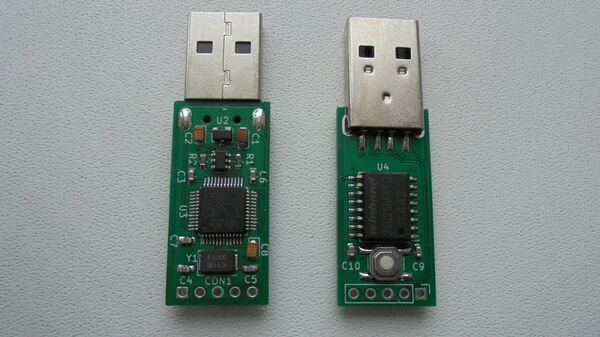
PocketAdmin – Keystroke Injection Device
"This is a keystroke injection device (also called badusb). It is similar to a well-known USB rubber ducky made by hak5, but has much extended functionality, lower price and is also completely open source. It looks and feels like an ordinary USB flash drive, but acts as a keyboard that types in a preprogrammed payload. This payload can do anything from configuring a network to installing a reverse shell, since the device can basically do whatever an admin can with a terminal, but taking only a few seconds. This makes it a very powerful tool for automating sysadmin tasks or use in penetration testing. Here is quick summary of how PocketAdmin is different from USB rubber ducky (and many others): - Made from inexpensive off-the-shelf parts, with not only open source firmware, but hardware design files as well." [...]

TTyGO
"VT220 serial terminal for Arduino TTyGO is a simple VT220 compatible serial terminal with some XTerm extensions with optional UTF-8 support. Hardware buttons act as VT220 programmable function keys, and there is an on screen keyboard available. It uses the U8g2lib graphical library, so it is compatible with a lot of displays. " [...]
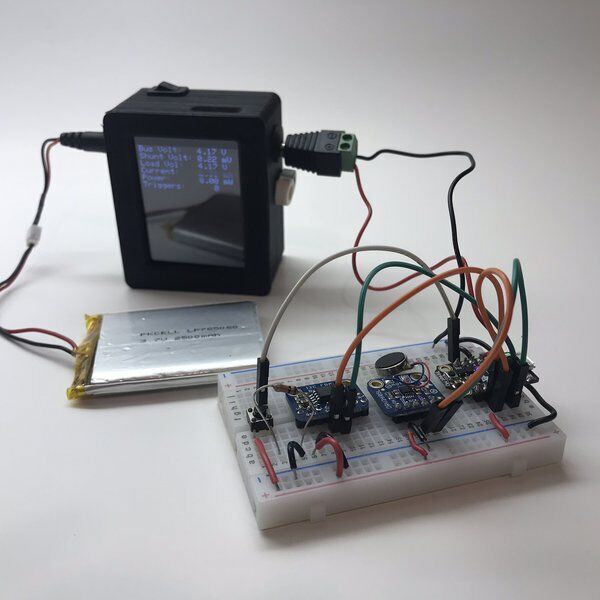
Voltage and Current Logger
"A low cost way to log voltage and current for wearable/IoT devices I needed a low cost way to measure current requirements and battery drain over time (for one of my wearable projects). I have a TON of Adafruit Feathers and FeatherWings, so I decided to use components I already had, plus an Adafruit INA219 FeatherWing to build a voltage and current logger. It logs to SD card, Adafruit IO, and has outputs for tracking and triggering "events" I'm in the process of building a small wearable device (the be better bracelet) and I wanted it to be as small as possible. I originally powering the wearable with a coin cell battery, but realized pretty quickly that those batteries didn't have the required mAh for my project (which includes a haptic motor). I needed a way to track battery life and current over time; I also wanted a way to easily trigger or record "events" (an action taken to take the project out of sleep). I didn't want to spend a lot of money on tools, so I looked into building something leveraging one of the 20+ un-used Adafruit Feathers (and FeatherWing accessories) in my electronics toolbox." [...]
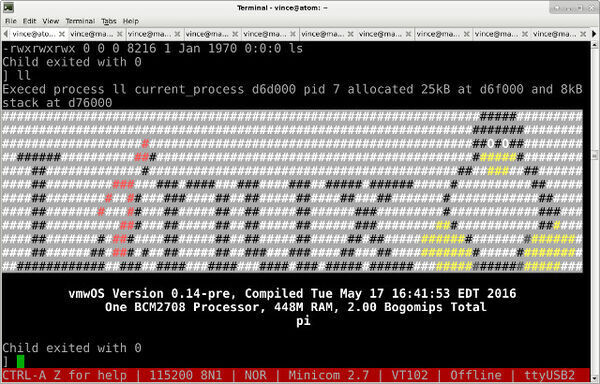
VMWos -- a homebrew operating system for the Raspberry Pi
"VMWos is a very small custom operating system that runs on Raspberry Pi Hardware. You will need a USB/serial cable to do anything useful with it. It was written in conjunction with the ECE598: Advanced Operating Systems class that I teach at the University of Maine (Spring 2015/2016/2018). " [...]
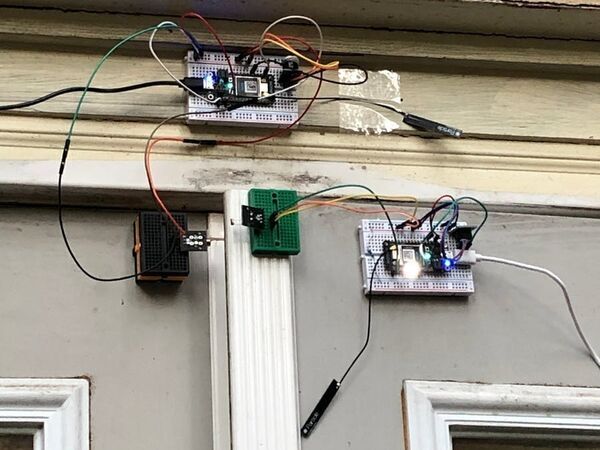
IOT Home Security System with Particle Argon
"Home Security at the touch of your fingers! Get notifications when your house door opens and sends an alert to your phone. Home security systems can be so expensive these days. It would be great if there was an easier, cheaper way to protect your home while you are away. Thankfully, you have arrived at the right place. This security-based project was chosen due to its continuous practicality." [...]
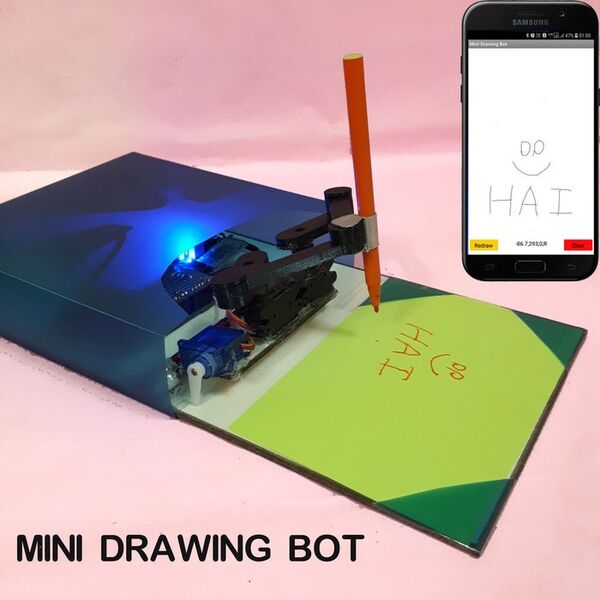
Mini Drawing Bot - Live Android App - Trignomentry
"Thank GOD and all of you for make my project Baby-MIT-Cheetah-Robot won the first prize in the Contest Make it Move. I am very happy because lot of friends ask lot of question in conversation and in messages. One of the important question was how the robot move smoothly (with out body up and down) and asked about the array in the program initialization, how it is calculated. For the answer of that questions i plan to make a drawing bot with the legs i designed for the Baby-MIT-Cheetah-Robot. This is the test leg first i designed before print all the four legs. Also for this i try to draw in android and transfer the data to arduino to draw." [...]

GPS interface using uLisp
"In this post I’m going to write about my experiments with interfacing a low-cost serial GPS module directly to uLisp, to create projects such as a GPS clock: I’ll also describe a GPS speedometer and odometer, and a simple navigator, in later posts. The module I used is the GP-20U7, a small GPS module available for under $20 from SparkFun GPS Receiver - GP-20U7 (56 Channel) 3, but almost any other GPS module should be suitable. The GPS Clock and GPS Speedometer/Odometer will work on any version of uLisp, with sufficient memory, such as the Arduino Mega 2560. The simple navigator requires a 32-bit version of uLisp, running on a board such as the Adafruit ItsyBitsy M0. " [...]
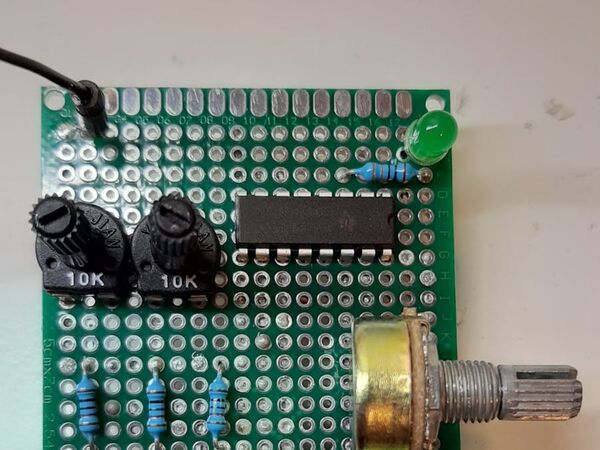
Multiplexing 8 Different Analog Signals Into One
"Everyone goes crazy for microcontrollers, but is there a way to channel my input signals into one bus? The answer is yes! Let's say we want to read 4 potentiometers (or variable resistors), and 3 buttons for some reason, and make those inputs light up a LED based on its value. We can do this by writing a few lines of code, setting 7 inputs, 4 of them analog and 3 digital ones, right? But as the title of the project, I want to use the CD4051 IC (integrated circuit) to channel the 7 inputs to output to only 1 pin! This is called multiplexing, and it's a very useful tool when trying to save on wiring, space, or efficiency." [...]

ATmega Alien Themed Slot Machine
"This is a three-reeled slot machine with 25 symbols on each reel. The game is configurable. This project is my implementation of an alien themed slot machine using two ATmega328P-PU micro-controllers. I was inspired by Cory Potter's Alien Invasion Slot Machine, and I wanted to expand on that idea. The slot machine is for entertainment and educational purposes only. I tried my best to make the game simulate a real slot machine as closely as possible." [...]
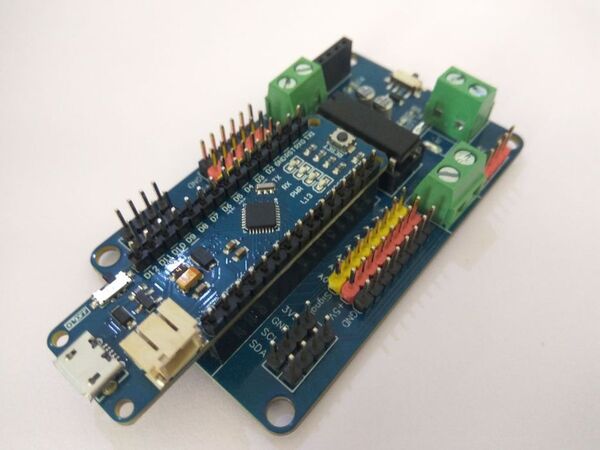
Nano Robot Controller & How to Use It
"Previously we have made a few robots using Arduino and ESP boards. If you remember it takes a lot of components along side the microcontroller itself to make a robot. There are Motor Drivers, Servo Controllers and voltage regulators. To connect all these components we need breadboard or Perf board to solder everything together. This may take a considerable amount of time and makes a mess with wires. This makes it hard for people dbug the connections if something goes wrong." [...]

Guitar Hero With Arduino
"The Arduino allows users to customize virtually anything they ever desire with a small amount of code. I decided to develop a Guitar Hero game with adjustable speed, volume, and multiple game modes. This project can also run off of 3 AA batteries so it can be portable. I hope you guys learn from this project and have fun customizing it! Let me know what you guys think! To get a general overview, please watch the video above." [...]
That's all Folks!



